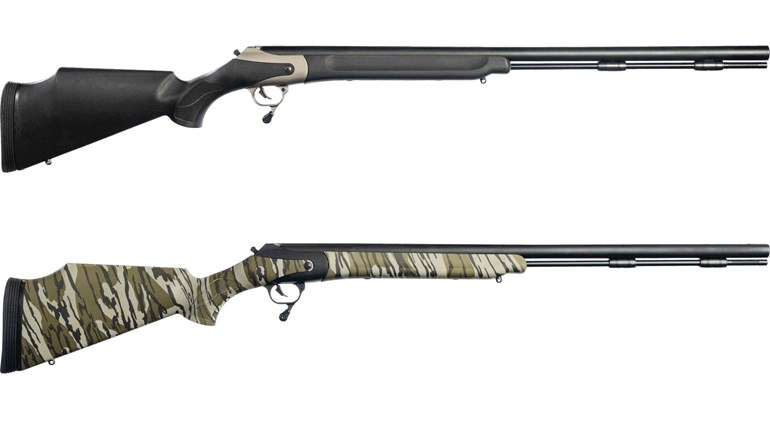
My shooting partner watched closely as I aimed the new in-line muzzleloader on the far-off deer. This “deer” was actually a life-sized target made of steel, and it was “standing” 200 yards away. That’s a long shot with any in-line, but I was not going for just the deer. I was going for my third consecutive heart shot. The wind was not strong, about 3 to 4 mph right-to-left. I knew I had to hold on the right side of the heart so the bullet would drift a couple of inches to hit it. As the rifle came out of recoil I heard the clang of the 250-grain Shockwave upon steel. “Nice shot,” said my friend. “Now do it again to prove you didn’t have three fluky hits.”
I first saw Thompson/Center’s Triumph in-line muzzleloader during a visit to the company’s factory in New Haven, Conn., in the summer of 2006. I noticed a unique muzzleloader standing in a gun rack in the research-and-development building. A pair of non-functional “side-plates,” a completely recessed hammer and a trim, two-piece stock made it look different than any in-line I had encountered. Noticing my curiosity, a young R&D specialist named Matt Zglobicki offered to show me the intricacies of its newest creation. Turns out, this muzzleloader is a clever amalgamation of design features from T/C’s two popular in-lines, the Omega and the Encore 209/Pro Hunter.
T/C borrowed a proven fire-control system from the Omega. The secret to the success of this trigger design is simplicity. There are few parts, and the ones employed are large and strong. The result is a clean, crisp trigger. My Triumph’s trigger breaks at 3 pounds even. Other Triumphs I have tested broke from 3-4 pounds. Triumph and Omega triggers hang uniquely since they sit in an angled-forward position in the trigger-guard opening. Cocking the hammer causes the trigger to move rearward into a normal firing position. The triggers have an interrupted design to eliminate the possibility of accidental discharge from a bump or drop. If the hammer is not cocked it cannot make contact with the firing pin.T/C surveyed shooters and learned that fighting with breech-plug removal was a primary negative factor in the use of in-lines. They solved the problem when they introduced the Pro Hunter’s Speed Breech with its interrupted-thread design—the breech plug is removed with a simple quarter-turn of the wrist.For the Triumph, Zglobicki took the concept a step further and came up with an improvement: the Speed Breech XT. Opening the Triumph’s action exposes a large, shiny, knurled ring that is the upper portion of the breech plug. The gun’s breech plug does not recess into the barrel like all other in-lines on the market. Instead, this knurled ring stops entering as the plug is screwed into the barrel. The breech plug removes with a twist of the fingers—no tools required! You simply break open the barrel assembly, grab the knurled ring between your thumb and first finger then twist 90 degrees. The plug pulls straight out.
T/C offers the following solution for residue: Two opposing cutouts in the face of the breech plug located at the 3 and 9 o’clock positions allow a steel bar to fit into the cutouts and provide additional leverage to loosen the plug, if necessary. If the breech plug is still stuck the shooter simply taps it out with the ramrod. After some of my torture tests the forward threads filled with residue and I could not withdraw the plug with my fingers; one or two light taps bumped out the breech plug every time.The Triumph also utilizes a Pro Hunter innovation to control blow-by of gases and residue—three blued carbon-steel gas-control rings are located at the front of the breech plug. I am surprised nobody thought of this simple solution before, since the automotive industry has used gas-control rings on engine pistons for decades.
There are a couple of significant differences between the Triumph and the Encore 209/Pro Hunter. First, the barrel of the Triumph is not interchangeable; it is a muzzleloader only. Secondly, the action of the Triumph is opened by pushing forward on a small lever cast into the forward area of the trigger guard. Pull back this lever to lock the action prior to shooting. After loading, merely snap the action closed—there is no need to manually lock it. The Encore/Pro Hunter is the opposite: The shooter must pull the handle toward himself to break open the action. I prefer the simplicity of the Encore, but I found that I quickly adapted to the operation of the Triumph lever.
For harsh-weather hunters, T/C developed Weather Shield, a ceramic coating that offers exceptional protection from abrasion, corrosion and moisture.
Both production rifles shot well with either two or three Pyrodex pellets or Triple Seven pellets behind a 250-grain T/C Shockwave bullet. I prefer the improved performance of the three-pellet (150-grain) loads. I also shot 130 grains of American Pioneer Powder with Barnes and T/C bullets. Accuracy was similar to the pellet loads but velocity dropped a bit in both rifles. I have not killed any game with the Triumph yet, but, with luck, that will change.




































